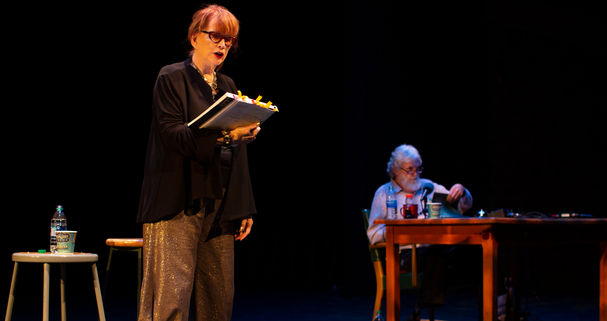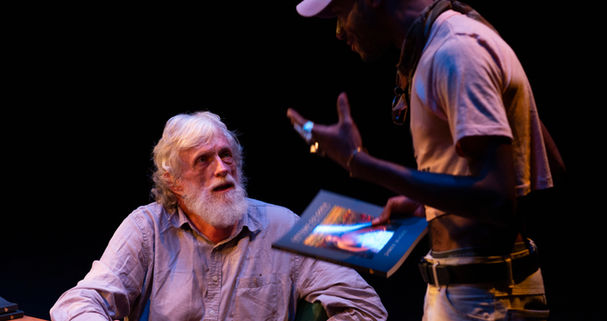
LETTERS TO GOYA: POEMS, TITLES AND LETTERS TO THE DEAD
By James Magee
Staged Reading with James Magee & Camilla Carr
In association with Marfa Book Company
Saturday, October 5, 2019
7:30 pm (Doors at 7:00pm)
Crowley Theater
In association with Marfa Book Company, Marfa Live Arts presented a performative reading from James Magee's new book Letters to Goya: Poems, Titles and Letters to the Dead at the Crowley Theater on October 5th. Published by El Paso’s Cinco Puntos Press, Marfa was the first stop of Magee’s second tour of the book. Award-winning actor/playwright Camilla Carr joined Magee on stage to bring to life his work. This production has played to standing-room-only audiences in Dallas, New York, Houston, and El Paso.
The enigmatic James Magee is the creator of the colossal desert stonework, The Hill, permanently installed east of El Paso. Art scholar/critic Richard Brettell once referred to Magee, who has lived and worked in El Paso since 1981, as “America’s greatest living unknown artist.” The Smithsonian recently purchased Magee’s archives whose body of work includes sculptures, paintings, poetry, film, performance art, and The Hill – a site that he has been building in the desert for more than 40 years. His sculptures and paintings have been presented in major exhibitions across the United States, Mexico and Europe, and he has most recently traveled across the country presenting readings from his new book Letters to Goya with a live musical score.
Letters to Goya – one “book” in this volume – is a collection of fictional letters written in the 1950s by The Duchess, a resident of the Waikiki Trailer Park in Sweetwater, Texas, to the 18th-century artist Francisco Goya. The letters are researched time capsules containing references to Mickey Mantle, polio, drive-in movies, a new luxury – the portable, window air conditioner – and other observations from a kinder, gentler time and place.
The Duchess’s letters reflect Magee’s original sense of humor and love of life. Her words about kindness and the art of living are a reflection of the writer’s heart. In one letter, The Duchess signs off with “Love, Forgiveness & Understanding,” while in another she says “...this world would be a better place if we just stopped yacking for a moment and kissed someone, I mean anyone...”
“Titles” – the other “book” in this volume – is further evidence of Magee’s unique artistic vision. Unlike the short, pithy titles typically used by artists, Magee’s titles are poems – “miniature dramas” – written as companion pieces for specific sculptures that he created over four decades. Interspersed with the “titles” are photographs of the sculptures that inspired the poems, often long after the sculptures were created.
This event will be a poignant and special night at the theater. We hope you will support our efforts to bring James Magee’s original and authentic theatrical performance of his Letters to Goya to our community.
MAGEE BIO:
In 1978, the incredibly prolific American artist (and now published poet) James Magee rooted himself in El Paso and Juarez on the U.S. Mexico Border. Michigan-born, Ivy League-educated to be a lawyer, gender-fluid, ex-taxi driver and off-shore roughneck, Magee made his home on the border because he had work to do, big work, big visionary work, and the frontera was a place to be alone to do that work, away from all the jingle-jangle of the NYC arts scene. Besides, he could cross the border and hang in the gay and transgender bars, he could live any life he wanted to live, and he could be the artist (or artists) he wanted to be. The place radiated renegade freedom. Besides, it was a cheap place to be an artist. Somehow, he bought 2,000 acres in the desert wilderness east of El Paso, and began creating The Hill, a massive stone work on the scale of Stonehenge, his on-going opus of the last four decades. He also created large metal collages, ornately framed, which he “titled” with remarkable poems. And then the artist Annabel Livermore (a retired Mid-Western librarian) sprang from Magee’s imagination like Athena sprang from the mind of Zeus. Annabel was not to be alone. Horace Mayfield, a gay artist, likewise sprang fully formed from the same imagination. Annabel lives in one house, Horace lives in another, and Magee migrates between the two. (Mayfield’s house, it should be noted, is outfitted for wheel-chair access because along the way Magee lost both legs to disease. It didn’t slow him down, thanks to prosthetics and incredible determination.) The sculptures and paintings of James Magee and Annabel Livermore (and more recently, Horace Mayfield) have been presented in major exhibitions across the United States, Mexico and Europe. Magee’s The Hill is quickly becoming an art aficionado’s destination, except visits are rare and managed by The Cornudas Foundation. The Smithsonian recently purchased Magee’s archives. A remarkable performer, James Magee traveled the country, performing his “Titles” (aka, poems) in collaboration with avant-garde classical musicians, and The Hill inspired Joan Jeanrenaud, founding cellist of the Kronos Quartet, to compose the concert “Desert Boy on a Stick”, which the quartet performed in concert with Magee in Houston. This book of poems, Letters to Goya: Poems, Titles and Letters to the Dead, is Magee’s first general trade publication.
Photos by Willy Somma.
LINKS:
James Magee: The Hill & His Art
Smithsonian Oral History of James Magee
Art&Seek on Think TV: Artist James Magee
THANK YOU:
Letters to Goya: Poems, Titles and Letters to the Dead is generously supported by City of Marfa and The Rea Charitable Trust. In-kind support provided by Hotel Saint George. Special thanks to Marfa Book Co., Crowley Theater, Cinco Puntos Press, Ed Holland, Carolyn Pfeiffer, Tim Johnson, Caitlin Murray, Tim Crowley, and Dedie Taylor, Lee and Bobby Byrd.

















